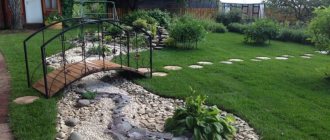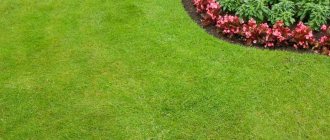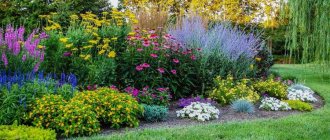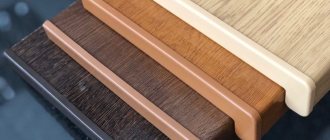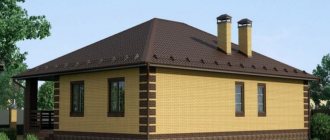Planning
Before deciding the question “How to make a beautiful front garden”, you need to decide:
- with the size of the area allocated for it (a small front garden will be lost in a large area or will not accommodate all the planned plants);
- possible time spent on his care;
- material costs for the purchase of seeds or seedlings;
- seasonality of flowering (it is preferable to choose plants that can bloom all season, and for residents of a year-round home to purchase evergreen plantings);
- sun exposure of the area.
By the way, even a small, inexpensive flower garden with the most ordinary plants can look very attractive if you put some of your soul into it.
Front area
The front area usually carries the main “representative” load and determines the perception of the main object on the site - a residential building. The most commonly used garden elements in this part of the site are parterre lawns and flower beds, free flower arrangements, as well as plantings of coniferous or decorative deciduous trees and shrubs. In the front part, a pond, fountain or other water features are sometimes installed to enliven the area. It is advisable to provide for the placement of garden benches, canopies from the sun and rain, or places for relaxation and conversation with guests.
It is known that open or semi-open spaces look friendlier than closed ones. The shape and dimensions of the front part of the site also matter. A square, rectangle or circle is preferable to an irregular shape or an elongated strip.
When, at the entrance to the site, there is enough space to “spread the eye”, the house, located at some distance, in the depths of the site, focuses attention on itself and is perceived as a whole, and the ground part plays the role of a rich frame for it.
If the house is pushed towards the street, the ground area of the site, which is also the entrance, will, at best, be reduced to the front garden. Thus, the owners often close themselves off from the disturbing world around them and at the same time free up space for their private garden, located behind the house. This is an example of an introverted garden, intended for a narrow circle of people; it can be found in England, and in Holland, and in our country.
The sophistication of the landscape design of the front part of the site must necessarily be combined with the functionality of this territory. No design findings can compensate for basic inconveniences that may relate to the nature of the road surface, the location and size of gates and wickets, the width and turning radius of the entrance road, the magnitude of the slopes, the placement of paths and many others.
When calculating the balance of a site's territory, fairly large areas of paved surfaces are usually provided for the front area. If in general, on a personal plot, hard covering occupies approximately 10–15% of the territory, then in the front part it can be 20–25% or more. Indeed, here, as a rule, there is an entrance road, and often a parking lot and pedestrian paths.
Basic Rules
A beautiful front garden design should take into account all its components.
The location and composition of the selected plants harmoniously complement the existing plantings. The fence and decorative elements are in the same color and stylistic range with the rest of the decorations on the site.
At the same time, we should not forget that most often the front garden is the face of the house and land plot, and the first impression of the territory depends on it.
Porch decoration
The porch should be in stylistic unity with the path leading to it and represent the design culmination of all the previously described elements. Usually there are several steps leading to the door, since in Russian conditions the house is slightly raised above ground level.
On the upper platform or on the steps themselves, the entrance group can be framed by two flowerpots with plants. Depending on the tastes of the owners and the style of the entire site, they choose either laconic thujas in low, simple terracotta-colored pots, or picturesque pansies in flowerpots with legs decorated with magnificent stucco. An asymmetrical arrangement of decorations is also suitable. In this case, you can place several pots of flowers on one side of the stairs - for example, across a step.
According to landscape designers (Moscow), in a country house at the entrance, a lantern or lamp will be a simply necessary functional element: it can be hung under the porch canopy, placed on the steps or installed permanently, for example, on a stone railing.
In Europe, where the traditions of decorating porches and doors are very strong, it is customary to decorate these objects in a special way for the holidays: before Christmas, the door is decorated with a wreath, garlands and lighting; on Halloween, pumpkins or lamps made from them are placed at the entrance. As a result, on holidays the entrance area looks even more hospitable than always.
Color options
Flowers in the front garden are selected very individually.
Here you can plant perennial plants that do not require much trouble, or annuals that will decorate the flower bed in front of the house in a completely new way every year. The usual ones will look good and traditional:
- velvets;
- nasturtiums;
- carnations;
- daffodils;
- periwinkles;
- hoofweed and other simple inhabitants of the beds.
But if you get a little creative, you can come up with unique selections of flowers and greenery. The following compositions will be interesting combinations:
- elegant begonias with red and pink buds, gracefully shaded by silvery branches of cineraria;
- noble roses and fairly simple lupins and foxgloves;
- fluffy peonies and delicate daylilies, bright phlox, exquisite irises;
- charming hydrangeas that perfectly cover all the shortcomings of the house;
- exquisite delphiniums, lilies, lupins, arranged in a white wave;
- hosta and ferns.
You can create a completely unusual front garden with your own hands if you replace the usual flowers with ordinary vegetables, beautifully arranged around the central element.
A front garden in the form of a prairie, created from grasses, will look original, but such a solution will require quite complex care.
Which style to choose
The Russian style is characterized by a riot of colors, the presence of Slavic sculptures and painted household utensils (jugs, pots, etc.) in the compositions. A boletus mushroom, a basket with berries and animal figurines will fit perfectly into this style.
The European style is characterized by minimalism, trimmed lawns, perfectly smooth paths, and the absence of funny, cute figures and sculptures.
Asian, done in restrained colors, not bright colors, definitely a stone fence and compositions of several tiers.
The romantic style is traditionally presented in the form of a bench, always forged, climbing plants, a flower garden with a selection of white and mixed flowering plants, and a low fence.
Japanese style. Slides made of stone, planted with coniferous trees with elements of dwarf plants.
Designing a front garden in front of a house with your own hands is a creative process and gives you the opportunity to choose any style, embody a bold idea, but it is desirable that in the finished version you get exactly what you wanted - a beautiful, stylish, complete composition. To get what you want, you need to understand the nuances of the process in more detail.
Potted compositions
The usual flowers in the front garden can be replaced with compositions of house or garden plants in pots. Such a solution will add originality and make it easier to care for a pretty flower garden, and will help create the most unusual design of the local area.
- As the plants fade, the pots are simply replaced with pots with fresh flowers, which maintain the attractive appearance of the front garden throughout the season.
- At the same time, it is not at all necessary to buy expensive flowerpots; you can use already worn-out pots or even repainted garden buckets or watering cans.
- A similar front garden can be arranged on the steps of a house, adding additional charm to the building and giving it the appearance of an old manor.
Execution Sequence
Make a detailed plan of the site, plan the location of all zones and correctly form groups of plants, so that later tall plants do not end up in a group with short ones, otherwise in the future you will have to decide whether to cut down the tree or replant the flowers.
Having decided on the type of front garden and fence, you can begin choosing the interior design of the site.
Divide the territory into zones and thoughtfully fill each of them with elements, taking into account their compatibility in shape, color and style.
Having decided on all the components, you can proceed to the financial side of the issue. Having made the first “rough” calculations, we can make a conclusion whether it is actually possible to implement it, or whether the costs exceed the possibilities. If difficulties arise, you can simply review the materials and their cost and find an alternative.
Lawn
A good solution would be to arrange the local area in the form of a green, well-groomed lawn. Small flower beds are laid out on it or garden decor, benches, and cozy gazebos are placed.
Paths or walking paths are laid in a large local area.
Plant selection
When choosing plants, you should be guided by the following methods:
- Rules of care.
- Compatibility of plants with each other.
- Flowering period.
- Appearance in different seasons.
- Frost resistance.
- Lifetime of plants.
- The style in which the garden is designed.
Fence
A front garden cannot do without a small fence. They can be:
- decorative fence for the front garden made of plastic, wood, metal, chain-link mesh;
- border of flowers;
- brick fencing;
- strip of lawn grass;
- stone embankment.
Brick or stone chips can also be poured inside the front garden, creating an attractive and fashionable rock garden.
Forged front gardens will look unusual, but such a solution is quite expensive in terms of money. And you will need an appropriate environment.
As the photo of the front garden in front of the house shows, installing a small wooden picket fence or fence will be much more pleasant. Soft lines and natural materials will make the flower garden near the house look as natural as possible.
A small net with vines running over it will help make the fence cozy and green, whimsically covering the plants and the house from prying eyes.
container garden
This is a popular solution for modern times. In this case, you can create a so-called portable garden. For this you will need various flowerpots, pots and flowerpots.
A distinctive feature of such a portable garden is that you can simply exchange one pot of plants for another. Trees in large tubs will look unusual. Chrysanthemums, hydrangeas and coleus are well suited for such a front garden.
Decor
Decorating the front garden will complete the design of the area. Here you can place:
- small garden figurines;
- homemade things;
- beautiful clay jugs;
- charming fountains;
- streams of stone or flowers;
- tiny benches.
In a large area, you can even arrange a nice pond made of polyethylene or tires, decorated with stones and herbs.
Artificial flowers are rarely used in the plant kingdom, but sometimes they also complement the intended composition well.
It is believed that the abundance of decor and flowers makes a small front garden a little larger, but it is not recommended to plant the area in front of the house too abundantly. The decor can be changed at least weekly, quickly and easily transforming the front garden.
A bush or small tree will add additional volume to the front garden. Selecting flowers and decor, planting plants and creating a fence can become the favorite task of the landlady, emphasizing the design of the territory and the house.
Path to the house
The main functional responsibilities are to ensure passage through the front garden, so you need to take into account the climate zone and select the material in accordance with the weather conditions.
The path in the front garden is a separate element of aesthetic addition, so it can be made of decorative stone, tiles, sprinkled with crushed stone, gravel and combined with various decorative accessories.
Creativity, in any of its manifestations, has a beneficial effect on the human body, promotes good mood and increased vitality. Desire and a little patience are all that a creative person needs and the front garden of your dreams is already a reality.
Setting up a rock garden in a small area
When choosing a location for an alpine slide, you must first take into account the most advantageous angle. In addition, if you want to spend free time near the rock garden, you will need to arrange paths, as well as an area with space for a table and a fireplace.
Construction of a rock garden begins with the selection of territory and its preparation. Its construction is not a pile of stones, but, on the contrary, is a high-quality imitation of a natural mountain landscape.
One large cobblestone or several smaller stones is a symbol of a rock garden. There is no need to lay stones at a great distance from each other, otherwise the slide will look lifeless and dull, regardless of the number of plants. Low-maintenance shrubs and low-growing perennial plants are a priority when creating rock gardens.
Wrought iron fencing for front gardens
A metal fence made using forging is a structure that can be either small, about 30 cm, or impressive up to 3 meters in height. Such a fence will help protect the front garden from impacts, including mechanical ones.
Large structures must have a foundation and must be concreted to avoid collapse. Forged front gardens are distinguished by the fact that their main function is protection, and the rest, including aesthetics and compliance with the exterior, is secondary.
Design of small front gardens
If the front garden occupies a small area near the house, but there is a desire to decorate it, then this can be done as follows:
- Arrange a beautiful central flower bed or lawn with flower beds.
- Mixborder near the terrace that can bloom all year round.
- Gazebo.
- A curving path framed with flowers.
- Make discounts with flowers of the same type.
Bridges
If the area in front of the house is large, then decorative bridges can be placed on it. They are an additional item that gives the site a special chic. Even a small design will make the overall picture more original.
Bridges are used to highlight a particular zone. They can be installed above a stream or other source of water. Designers use such a concept as “dry stream”. He can extend the path or position himself directly on it.
The most successful material for a bridge remains wood. Pine is the best wood for piles. You can also build a structure made of brick or stone.
Concrete patios
The durability and versatility of concrete makes it an excellent choice for paving your patio. A concrete patio has many advantages compared to corrugated sheets and other surfaces.
Concrete patio in the courtyard interior
Benefits of concrete patios:
- Highly durable.
- Low operating costs.
- Adaptable to any style.
- Can be poured into any shape.
Decor options:
- Colored concrete. There are several ways to paint concrete, including contrasting, integrating, solid and liquid painting methods (used in combination with embossing), and full staining.
- Embossed Concrete – The surface of your concrete patio can be stamped to create a texture that mimics stone, brick or other materials.
Embossed colored concrete to look like stone
If you already have a patio that is cracked or dirty, you can clean it with concrete. Concrete sanding will make your patio look like new. A reclaimed concrete patio can be painted and stamped.
Another strong trend is to integrate plants into areas where expansion joints would otherwise be located. They help create a more breathable surface and break up the vast structure with greenery. It is not uncommon to use artificial turf in these areas, especially in areas where moisture needs to be maintained.
Grass between seams to maintain moisture
Are concrete patios susceptible to cracking?
Concrete is good for warm climate landscapes that do not experience the extreme freeze-thaw cycles of northern regions that cause uncontrolled cracking. Other factors can also lead to cracking.
This will be of interest to you: Do-it-yourself landscape design for the garden (185+ Photos). Styles You Should Know About
The concept of a flower garden and flower bed
A flower garden refers to any specially planted ornamental plants. There may be a complete absence of a clear shape or border of the plantings. Plants can be placed in any mixture.
A flowerbed is a clearly organized planting. Flowers are placed structurally, in a given sequence. There is symmetry here. The contour of the flowerbed is clear and closed. The shape usually has geometric outlines.


